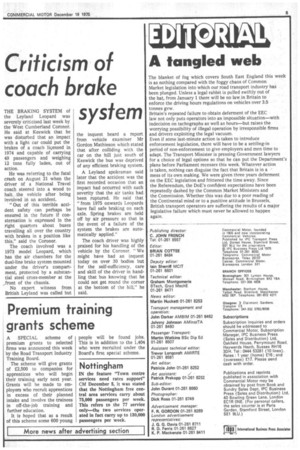Criticism of coach brake system
Page 7

If you've noticed an error in this article please click here to report it so we can fix it.
THE BRAKING SYSTEM of the Leyland Leopard was severely criticised last week by the West Cumberland Coroner. He said at Keswick that he was disturbed that an impact with a light car could put the brakes of a coach licensed in 1974 and capable of carrying 49 passengers and weighing 12 tons fully laden, out of action.
He was referring to the fatal crash on August 21 when the driver of a National Travel coach steered into a wood to halt the vehicle after being involved in an accident.
"Out of this terrible accident safety can perhaps be ensured in the future if consternation is expressed in the right quarters about buses travelling all over the country with brakes in a position like this," said the Coroner.
The coach involved was a 1973 model Leopard, which has the air chambers for the dual-line brake system mounted under the driver's compartment, protected by a substantial steel cross-member at •the „front of the chassis.
No expert witness from British Leyland was called but the inquest heard a report from vehicle examiner Mr Gordon Mathieson which stated that after colliding with the car on the hill just south of Keswick the bus was deprived of any efficient braking system.
A Leyland spokesman said later that the accident was the first recorded occasion that an impact had occurred with such severity that the air tanks had been ruptured. He said that "from 1975 onwards Leopards have fail safe braking on each axle. Spring brakes are held off by air pressure so that in the event of a failure of the system the brakes are automatically applied."
The coach driver was highly praised for his handling of the vehicle by the Coroner. "We might have had an inquest today on over 30 bodies but for the self-sufficiency, care and skill of the driver in handling that bus knowing that he could not get round the corner at the bottom of the hill," he said.












































































